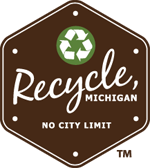Food Waste
Where to Compost: At home or Community Drop-Off
Food waste should be disposed of using the EPA Food Waste hierarchy, which recognizes that we should produce and purchase food quantities for the demand needed, reducing production of food that will only later be wasted. Next, when food is not expired it should be donated, and first used to feed people in need and second to feed livestock and animals. Feeding America is one of the largest agencies in the country working to end hunger and prevent waste.
Many communities collect yard debris for composting at designated drop-off sites. A limited number of communities are also beginning to consider adding food scraps to yard debris collection programs and curbside collection programs. Call your local recycling contact to learn about yard debris and other organic management in your community or find the List of EGLE Registered Composting Facilities here. Great resources for learning more about how to start your composting at home journey include the Earth Easy backyard composting guide and the EPA’s Preventing Wasted Food At Home resource and guide.
Why should you compost and reduce food waste?
When organic materials such as yard debris and food scraps are added to the oxygen-deprived environment of a landfill, those materials break down and contribute to the release of harmful greenhouse gasses. When food is wasted we are also wasting water, fertilizer, land-use, energy, and biodiversity.
According to the US Department of Agriculture (USDA), each day one pound of food is wasted per person. In 2017, 103 million tons or over 81 billion pounds of food waste was generated. The amount of food that is wasted is about 30 to 40 percent of the total food supply. Overwhelmingly the most food or about 45% of wasted food is produced by food retailers and consumers according to a Commission for Environmental Cooperation characterization study.
Why can’t this item go in my curbside bin?
Organic waste is not a recyclable material. Organic waste must go to a composting facility or business to undergo a composting process in which it can be made into a valuable soil additive.


CEC. 2017. Characterization and Management of Food Loss and Waste in North America. Montreal, Canada: Commission for Environmental Cooperation. 48 pp.
